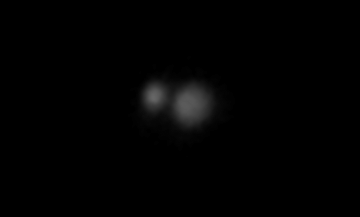| SATELLITE COLLISION: On Feb. 10th, 2009, Iridium 33 collided with Cosmos 2251 over northern Siberia, and the two satellites were shattered. US Strategic command has since catalogued 981 pieces of debris, 25 of which have already reentered Earth's atmosphere. On this three-month anniversary of the collision, veteran satellite observer Daniel Deak has prepared a set of 3D orbital debris maps. Broswe the links to see where the fragments are located on May 10, 2009: Iridium 33: #1, #2, #3, Cosmos 2251: #1, #2, #3. BONUS: A large piece of Iridium 33 wreckage is visible to the naked eye as it tumbles through the night sky flashing every 4.7 seconds. Check the Simple Satellite Tracker for flyby times. SOLAR RADIO BURST: On May 9th at 1614 UT, the sun emitted a strong shortwave radio burst. Amateur astronomer Thomas Ashcraft recorded the event using a 21 MHz radio telescope in New Mexico. Click on the image to listen: 
The loud swishing sound you just heard is a combo Type III-Type V solar radio burst caused by electron beams moving through the sun's outer atmosphere. The source of the electrons is probably an active region now emerging over the sun's eastern limb. The unnumbered region is crackling with low-level A- and B-class solar flares, and it could produce more radio sounds in the days ahead. Ham radio operators, point your Yagis toward the sun! more images: from Jesper Sorensen of Kastrup, Denmark; from Mike Borman of Evansville, Indiana; from Peter Paice of Belfast, Northern Ireland; from Lars Zielke of Tvis Denmark; from Cai-Uso Wohler of Bispingen, Germany; from Guenter Kleinschuster of Feldbach, Austria; from P-M Hedén of Vallentuna, Sweden; from Pete Lawrence of Selsey, West Sussex, UK; from Stephen Ames of Hodgenville, Kentucky; from Mike Strieber of Las Vegas, Nevada; from Sylvain Weiller of Saint Rémy lès Chevreuse, France EUROPA OCCULTS GANYMEDE: On May 8th, Anthony Wesley of Murrumbateman, Australia, recorded a very rare event--one of Jupiter's moons eclipsing another. "Here," says Wesley, "is an animation of Europa passing directly in front of Ganymede." 
He made the movie using a 13-inch telescope and a digital video camera. "Seeing was not good, so I was only able to use 250 of the 1200 frames I collected." Nevertheless, it is an extraordinary observation, showing the distant moons as genuine world-like disks as they pass in "mutual occultation." Earth is moving through the orbital plane of Jupiter's satellites, allowing the moons to line up for events such as Wesley recorded on May 8th. This special geometry comes along approximately once every 6 years. The last time was in 2002-2003, and now it is happening again. Between April and December of 2009, observers around the world can see Jupiter's moons passing one in front of another as they circle the giant planet. As part of the International Year of Astronomy, professional astronomers are organizing a worldwide observing campaign to record as many of these events as possible. Click here for details.
April 2009 Aurora Gallery
[previous Aprils: 2008, 2007, 2006, 2005, 2004, 2003, 2002]
Explore the Sunspot Cycle | 
